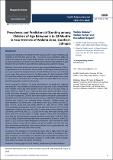Prevalence and Predictors of Stunting among Children of Age Between 6 to 23 Months in Four Districts of Wolaita Zone, Southern Ethiopia
View/
Publication Date
2020-08-14Type
Article, Journalviews
downloads
Metadata
Show full item recordCitation
Kidane W, Facha W, Negash K (2020) Prevalence and Predictors of Stunting among Children of Age Between 6 to 23 Months in Four Districts of Wolaita Zone, Southern Ethiopia. Health Sci J. 14 No. 5: 740.
Abstract/
mortality in the first two years of life. It is used to assess nutritional status of children by measuring their length/height and age. The purpose of this study was to assess prevalence and factors associated with stunting among children of ages between 6 to 23 months in four districts of Wolaita Zone, Southern Ethiopia. Methods: Community based cross sectional study was employed among children of ages between 6 to 23 months in January 2020. A multistage sampling technique was used to select the study participants. A total of 767 participants were included in our study. Data were entered into Epi data version 3.1 and exported to SPSS 20.0 statistical software for analysis. Bivariate and multivariate analysis was done to assess factors associated with stunting. Odds ratio with 95% CI was used to identify independent predictors of stunting. Result: Among 767 children, 759 were participated in the study with response rate of 98.9%. The prevalence of stunting in our study was 71.5%. Children born from mothers whose age were between 25-34 years and 35-45 years were 2.3 times; [AOR=2.3, (95% CI=1.37, 3.86)] and 3.09 times; [AOR=3.09, (95% CI=1.55, 6.18)] more likely developed stunting than mothers whose age were between 15-24 years respectively. Children born from mothers who did not attend formal education were 2.45 times; [AOR=2.45, (95% CI=1.25, 4.83)] more likely developed stunting than mothers who attended formal education. Children whose age were between 6-12 months and 12-18 months were 10.12 times; [AOR=10.12, (95% CI=6.34, 16.4)] and 6.16 times; [AOR=6.16, (95% CI=3.92, 9.68)] more likely developed stunting than children whose age were between 19-24 months respectively. Children who ever sick within 2 weeks prior to data collection were 1.68 times; [AOR=1.68,(95% CI 1.15,2.45)] more likely developed stunting than those who ever not sick within 2 weeks; however, those who fed colostrum were 49% less likely developed stunting than their counter part; [AOR=0.61 (95% CI=0.37,0.98)]. Children who were delivered at home were 2.38 times; [AOR=2.38, (95% CI 1.51,3.75)] more likely developed stunting than those delivered at health facility; however, those whose mother ever got postnatal care were 49% less likely developed stunting than those whose mother ever not got postnatal care after delivery; [AOR= 0.61 (95% CI=0.41,0.91)]. Conclusion: The prevalence of stunting in study area is high. Maternal age, maternal education, child’s current age, child sickness, colostrum feeding practice, place of delivery and postnatal care utilization were independent predictors for child stunting. Thus concerned body working on child health should consider these factors to reduce the burden of stunting.
ISSN
1791-809XCollections
- General - GEN [367]

